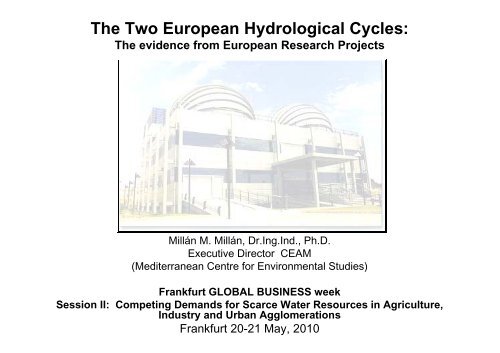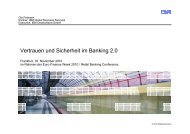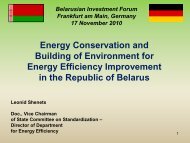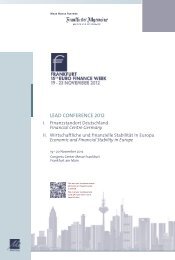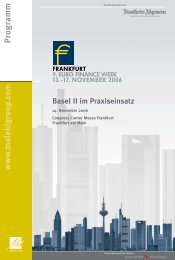The Two European Hydrological Cycles:
The Two European Hydrological Cycles:
The Two European Hydrological Cycles:
Create successful ePaper yourself
Turn your PDF publications into a flip-book with our unique Google optimized e-Paper software.
<strong>The</strong> <strong>Two</strong> <strong>European</strong> <strong>Hydrological</strong> <strong>Cycles</strong>:<br />
<strong>The</strong> evidence from <strong>European</strong> Research Projects<br />
Millán M. Millán, Dr.Ing.Ind., Ph.D.<br />
Executive Director CEAM<br />
(Mediterranean Centre for Environmental Studies)<br />
Frankfurt GLOBAL BUSINESS week<br />
Session II: Competing Demands for Scarce Water Resources in Agriculture,<br />
Industry and Urban Agglomerations<br />
Frankfurt 20-21 May, 2010
<strong>The</strong> first experimental data used for this work were obtained during the <strong>European</strong><br />
Commission Campaigns on Remote Sensing of Air Pollution in: LACQ (France, 1975),<br />
TURBIGO (Po Valley, Italy, in 1979) and FOS-BERRE (Marseille, France, 1983).<br />
Additional experimental and modelling results come from the <strong>European</strong> Commission<br />
research projects: MECAPIP (MEso-meteorological <strong>Cycles</strong> of Air Pollution in the<br />
Iberian Peninsula, 1988-1991), RECAPMA (REgional <strong>Cycles</strong> of Air Pollution in the<br />
Western Mediterranean Area, 1990-1992), SECAP (South <strong>European</strong> <strong>Cycles</strong> of Air<br />
Pollution, 1992-1995), T-TRAPEM (Transport and TRansformation of Air Pollutants on<br />
East Mediterranean, 1992-1995), MEDCAPHOT-TRACE (<strong>The</strong> Mediterranean<br />
Campaign of Photochemical Tracers-Transport and Chemical Evolution, 1993-1995),<br />
BEMA I (Biogenic Emissions in the Mediterranean Area, Phase I/ 1994-1995),<br />
VOTALP I (Vertical Ozone Transport in the Alps, 1996-1998), VOTALP II (Vertical<br />
Ozone Transport in the Alps, Phase II, 1998-2000), BEMA II (Phase II/ 1996-1998),<br />
MEDEFLU (Carbon and Water Fluxes of MEDiterranEan Forest and Impacts of Land<br />
Use/Cover Changes, 1998-2000), RECAB (REgional Assessment and Modelling of the<br />
CArbon Balance within Europe, 2000-2003), ADIOS (Atmospheric Deposition and<br />
Impact of pollutants, key elements and nutrients on the Open Mediterranean Sea,<br />
2001-2003), CARBOMONT (Effects of Land Use Changes on Sources, Sinks and<br />
Fluxes of CARBOn in <strong>European</strong> MOuNTain Areas, 2001-2004), MICE (Modelling the<br />
Impact of Extreme Events, 2001-2003), and FUMAPEX (Integrated Systems for<br />
Forecasting Urban Meteorology, Air Pollution and Population Exposure, 2002-2005).<br />
<strong>The</strong> new integrated project, CIRCE Climate Change Impacts in the Mediterranean<br />
(2007- 2011)
� 21g(H 2 O)/kg(air)<br />
2000 m �<br />
� 20g(H 2 O)/kg(air)<br />
2000 m �<br />
60 �100 km<br />
26º C<br />
14g(H 2 O)/kg(air)<br />
26º C<br />
14g(H 2 O)/kg(air)
DAY 10:30
DAY 10:30 & NIGHT 22:30
DAY
DAY 10:30 & NIGHT 22:30
DAY
DAY 10:30 & NIGHT 22:30
Average surface pressure for Europe in July
4<br />
3.5<br />
3<br />
2.5<br />
2<br />
1.5<br />
1<br />
0.5<br />
01-Ene-00 31-Dic-00 31-Dic-01 31-Dic-02 31-Dic-03 30-Dic-04 30-Dic-05 30-Dic-06 30-Dic-07 29-Dic-08<br />
4<br />
3.5<br />
3<br />
2.5<br />
2<br />
1.5<br />
1<br />
Western Mediterranean Basin<br />
Eastern Mediterranean Basin<br />
0.5<br />
01-Ene-00 31-Dic-00 31-Dic-01 31-Dic-02 31-Dic-03 30-Dic-04 30-Dic-05 30-Dic-06 30-Dic-07 29-Dic-08
4<br />
3,5<br />
3<br />
2,5<br />
2<br />
1,5<br />
1<br />
WMB<br />
EMB<br />
Total Precipitable Water Column<br />
1-ene 28-mar 23-jun 18-sep 14-dic
DAY 10:30 & NIGHT 22:30
Sea Surface Temperature SST (August 2003)
DAY 10:30 & NIGHT 22:30
Back trajectories (type V b ) that fed torrential rains in Germany and the<br />
Czech Republic on 11-13 August 2002, from: Uwe Ulbrich et al. (2003)<br />
Weather, 58, 434-443., and EC Project MICE (Modelling the Impact of Extreme<br />
Events, 2001-2003). Note that one of the source regions is the Western<br />
Mediterranean Basin, and compare with the average water vapour column<br />
accumulated during August 2002, shown in the previous figure
UP TO 90% OF PRECIPITATION<br />
IS OF ATLANTIC ORIGIN.<br />
SURFACE EFFECTS ARE MINIMAL
UP TO 90% OF PRECIPITATION<br />
IS OF ATLANTIC ORIGIN.<br />
SURFACE EFFECTS ARE MINIMAL<br />
MORE THAN 90% OF PRECIPITATION<br />
IS WATER RECIRCULATED WITHIN<br />
THE BASIN. SURFACE EVAPORATION IS<br />
A KEY TRIGGER MECHANISM
Nature, vol 437/27, October 2005<br />
Inventing an Icon: Hans Joachim Schellnhuber’s map of<br />
global “tipping points” in climate change
British Isles & NW<br />
Europe experience<br />
floods in summer &<br />
dry cold winters<br />
Summer drought<br />
followed by winter<br />
floods in Southwestern<br />
Europe &<br />
Northern Africa<br />
(+ ?) Perturbation<br />
to the NAO (North<br />
Atlantic Oscillation)<br />
Perturbations (?)<br />
to extra-tropical<br />
depressions &<br />
hurricanes, in<br />
the Western<br />
Atlantic South-<br />
Eastern USA<br />
Increased salty<br />
outflow to<br />
Atlantic<br />
� LAND-USE &<br />
SURFACE<br />
CHANGES<br />
Mud floods<br />
Augmented<br />
soil erosion<br />
Torrential rains over<br />
areas surrounding the<br />
Mediterranean<br />
increase in autumnwinter-spring<br />
Condensation<br />
nuclei<br />
transported<br />
across Atlantic<br />
to Caribbean<br />
Alter the MOISTURE�,<br />
HEAT�, & pollutants�<br />
added to seabreezes<br />
Loss of summer storms.<br />
Drought increases over<br />
coastal mountains and<br />
other inland areas<br />
Changes the evaporation─precipitation<br />
balance in the western basin. Salinity<br />
increases in the Mediterranean Sea<br />
Heterogeneous<br />
reactions in<br />
shallow clouds:<br />
sulphatation<br />
and nitrification<br />
of Saharan dust<br />
Combined greenhouse<br />
heating additionally<br />
increases the Sea<br />
Surface Temperature by<br />
the end of summer<br />
African routes:<br />
central and/or<br />
Southern Atlas<br />
(with vertical<br />
recirculations)<br />
* EVAPORATION<br />
FROM SEA<br />
+ Pollution Effects<br />
(e.g., nucleation)<br />
Cloud Condensation<br />
Level rises above<br />
coastal mountains<br />
Non-precipitated H 2O vapour<br />
& pollutants (O 3) follow the<br />
return flows aloft, and pile<br />
up in a system of layers, 4.5<br />
to 5.5 km deep, over the sea<br />
Aged airmass advected<br />
to other regions, in part<br />
(daily), or in toto (every<br />
� 3 to 10 days) �<br />
<strong>European</strong><br />
route-Vb tracks<br />
Summer floods<br />
in Central<br />
Europe: 1997,<br />
2002, 2005, ...
<strong>The</strong> <strong>Two</strong> <strong>European</strong> <strong>Hydrological</strong> <strong>Cycles</strong>:<br />
<strong>The</strong> evidence from <strong>European</strong> Research Projects<br />
by:<br />
Millán M. Millán, Dr.Ing.Ind., Ph.D.<br />
Executive Director CEAM, Valencia, Spain<br />
Member of the External Advisory Group in "Global Change and Ecosystems" for the<br />
<strong>European</strong> Commission's 6th Framework Programme.<br />
Synthesis of the Chapter "Climate change and drought: <strong>The</strong> role of critical thresholds and<br />
feedbacks", prepared by the author for the Report: Climate Change Impacts on the Water<br />
Cycle, Resources and Quality, Research-Policy Interface, <strong>European</strong> Commission, 2007:<br />
EUR 22422, Luxembourg: Office for Official Publications of the <strong>European</strong> Communities, 149<br />
pp. (ISBN 92-79-03314-X)<br />
Executive Summary<br />
Probably the most common assumption regarding the hydrological cycle is that the water<br />
resource is universally provided through precipitation by the large weather systems. As this<br />
is not universally true in most parts of the world, the conception that the water resource is<br />
there and all that is required is to manage it properly is perhaps the most widely extended<br />
fallacy regarding the water cycle. In the northern hemisphere (Slide 2), this assumption<br />
holds only in the Atlantic and Pacific Divides north of � 35º North Latitude. Moreover, it can<br />
only be truly asserted for the western side of the continents, i.e., the <strong>European</strong>-Atlantic and<br />
American-Pacific sides of the continents.<br />
For any other Water Divide (Basin) in the world, other processes must be considererd; for<br />
example, the available precipitation in the Central North American Basin, which is lodged<br />
between the Pacific and North Atlantic Divides, is strongly modulated by conditions in the<br />
Gulf of Mexico, i.e., by processes and conditions at the Regional to Subcontinental scales.<br />
In the forested tropical areas (rainforests), after a masive inflow of water vapour at the<br />
beginning of the wet season, the water is basically recirculated between the soil-forest and<br />
the atmosphere, producing a daily afternoon-evening shower. Thus, rainforest means<br />
exactly that; take the forest away and the rain goes along with it, for the area to become a<br />
desert. <strong>The</strong> rainforest is probably the ultimate case where surface properties govern the<br />
precipitation during the wet period.<br />
This document presents our findings about the hydrological cycle in Southern Europe (the<br />
Mediterranean Divide), and the path followed to reach these findings from information<br />
gathered during various <strong>European</strong> Commission projects from 1974 to 1994. <strong>The</strong>se had<br />
alerted of a loss of summer storms around the Western Mediterranean Basin. This issue<br />
was addressed in 1995 by re-analysing the meso-meteorological information obtained in nine<br />
of the EC projects (Slide 3) and disaggregating the precipitation components for one of the<br />
experimental areas used in the projects (Valencia, eastern Spain). <strong>The</strong> analysis shows that<br />
there are three sources of rain in this region, viz: Atlantic Fronts, Summer Storms, and<br />
Mediterranean Cyclogenesis, and that the last two are dominated by land-use-atmosphericoceanic<br />
feedbacks.<br />
Summer storms form (or used to form) in the afternoon, over the mountains surrounding<br />
the basin at 60 to 80(+) km from the sea, in a coastal wind system that develops during<br />
daytime and combines the seabreeze and the up-slope winds, henceforth called the<br />
combined breeze. In this system the seabreeze develops at mid-morning and progresses<br />
inland by incorporating, one after another, the up-slope wind cells formed earlier that day
(Slide 4). At the leading edge of the combined breeze the air is injected vertically upwards<br />
into the return flows aloft, and these move seaward and sink over the sea, forming a<br />
"closed" vertical circulation loop. Storms develop when the Convective Condensation Level<br />
(CCL) of the incoming airmass is low enough for deep (moist) convection to be triggered at<br />
the leading edge of the combined breeze. If storms do develop (Slide 5), the airmass<br />
becomes mixed all the way up to the tropopause, and the closed-loop coastal wind system<br />
becomes "OPEN".<br />
<strong>The</strong> formation of storms, however, requires the addition of water (evaporated from the<br />
surface) to counterbalance the heating that the airmass sustains as it moves inland along the<br />
surface, i.e., to bring its CCL below the height of injection into the return flows. Otherwise, its<br />
CCL will keep on rising, and a "first critical threshold" (or tipping point) may be crossed<br />
when the CCL remains higher than the height of injection over the mountain tops. In<br />
these conditions the coastal circulations will stay "CLOSED" (Slides 6 to 8) That is, storms<br />
will not develop, and the return flows aloft will continue moving seaward during the whole<br />
day, forming layers that contain the non-precipitated water vapour and the pollutants carried<br />
by the combined breeze, and piling them up to 4500(+) m over the Western Mediterranean<br />
Basin.<br />
Moreover, if the closed-loop conditions develop in other coastal areas they can become<br />
self-organised at the meso-� scale of the whole Western Mediterranean Basin. <strong>The</strong>se<br />
"closed loop" conditions can last from 3 to 9 consecutive days, and recur several times a<br />
month, i.e., for a total of 12 to 24 days per month, from late spring to late summer (May-<br />
September). During these periods, from � 1/4 to 1/2 of the depth of the layers accumulated<br />
over the sea on the previous days is recirculated vertically over the basin each day. And,<br />
because no storms develop, and there is no precipitation inland, these conditions can be<br />
considered part of a first feedback loop that tips the local climate towards increased<br />
drought inland (Slide 31).<br />
Current numerical simulation models cannot capture all the details of the observed<br />
processes; e.g., they cannot reproduce either the vertical recirculations or the layering over<br />
the sea. Nevertheless, the outcome of these processes, i.e., the development of an<br />
accumulation mode for water vapour (and pollutants) over the sea, has been validated with<br />
water column data from NASA-MODIS since 2000. MODIS data show that there is an<br />
intense and prolonged accumulation mode over the Western Basin and the Black sea in<br />
summer, and two weaker accumulation modes over the Eastern Basin in spring and autumn<br />
(Slides 9 to 17).<br />
<strong>The</strong>se vertical recirculation-accumulation modes make the weather and climate in the<br />
Mediterranean Basin absolutely different from any other place in the world. Thus, in<br />
contrast with regions dominated by advection, in the Western Mediterranean Basin, water<br />
vapour and pollutants can accumulate in layers piled-up to 4500(+) m over the sea, for<br />
extended periods during the summer. And, without requiring the high evaporation rates of<br />
more tropical latitudes, the above-described mechanisms are able in just a few days to<br />
generate a very large, deep and polluted airmass that increases both in moisture content and<br />
in potential instability with each passing day.<br />
At the end of each accumulation period (i.e., every few days) the moist and polluted<br />
airmasses are vented out of the area and can contribute to summer floods in Central and<br />
Eastern Europe (Slides 23-24). Moreover, during the vertical recirculations, the greenhouse<br />
effect of the water vapour, photo-oxidants (ozone) and aerosols accumulated in layers over<br />
the sea enhance the sea surface water heating during the summer (Slides 18 to 22). This<br />
propitiates a second feedback loop (Slide 31) where Mediterranean Cyclogenesis fed by a<br />
warm(er) sea contributes to an increase in torrential rains and floods in Mediterranean<br />
coastal areas from autumn to spring (i.e., effects delayed by a few months with respect to the
closing of the first loop).<br />
A "second critical threshold" can then be crossed in the second feedback loop during<br />
intense Mediterranean cyclogenesis events, when torrential rains trigger mud flows over the<br />
drier and vegetation-deprived mountain slopes already affected by the first feedback loop.<br />
This can result in massive soil losses and a further reinforcement, and propagation of the<br />
effects caused by the first feedback loop, etc. Available evidence not only indicates that<br />
these processes and feedbacks have been operating in the Mediterranean for a long time,<br />
but also suggests that fundamental changes, and long-term perturbations to the <strong>European</strong><br />
water-cycle (droughts and floods), are taking place right now.<br />
This analysis further suggests that: up to 75% (or more) of the precipitation in southern<br />
Europe, i.e., from Summer storms and Mediterranean Cyclogenesis, originates from water<br />
that first evaporates and then precipitates, i.e., it is recirculated, within the major<br />
Mediterranean drainage basin (i.e., all the areas south and east of the <strong>European</strong> Continental<br />
Divide including the Mediterranean and Black seas, Slides 25 and 27). Moreover, on the<br />
Mediterranean side of this divide, rain of Atlantic origin contributes less than � 20% of the<br />
total (probably even less than that in Greece), in stark contrast with the Atlantic side of the<br />
<strong>European</strong> Divide where � 80% or more of the precipitation is from water evaporated over the<br />
Atlantic (Slides 28-29).<br />
Finally, land-use appears to play a key role in the loss of summer storms, the shift to more<br />
frequent vertical recirculation periods, and the amount of water recirculated within the basin.<br />
<strong>The</strong>se findings and the questions they raise are critical for <strong>European</strong> Union water policies in<br />
Southern Europe because:<br />
(a) water from precipitation tends to be treated as a given resource without duly<br />
considering its origins,<br />
(b) disaggregation of precipitation components is not normally performed in climatic<br />
studies and,<br />
(c) the feedback processes in the hydrological cycle, which govern the partitioning and<br />
the recycling of the precipitation in each region, cannot be simulated in the Global<br />
Models used to assess future water scenarios for Europe.<br />
Thus, the decisions on the future of the water cycle, and particularly the timing of such<br />
decisions, could be absolutely wrong and have catastrophic consequences for Southern<br />
Europe. This work presents a summary of the evidence we use to support this statement<br />
(Slide 31).


